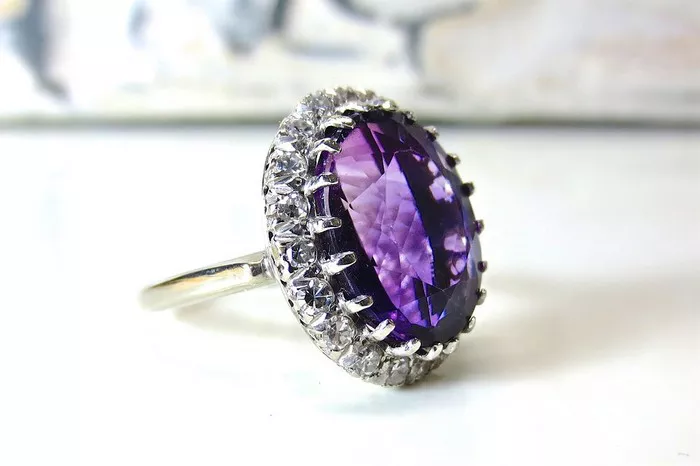Gemstones have fascinated humans for millennia, captivating our imagination with their vibrant colors, intricate patterns, and unique properties. Among the myriad of gemstones, amethyst and fluorite stand out due to their striking appearances and intriguing characteristics. While these two gemstones may seem worlds apart, they share a unique symbiotic relationship that is both fascinating and worth exploring. This article aims to provide a detailed introduction to amethyst and fluorite, delving into their properties, occurrences, and the reasons behind their symbiotic relationship. By the end, readers will have a clearer understanding of these gemstones and the intriguing bond they share.
Introduction to Amethyst
The Purple Enchantment of Amethyst
Amethyst is a variety of quartz that displays a captivating range of purple hues, from light lavender to deep indigo. Its name, derived from the Greek word “amethystos,” translates to “not drunk,” reflecting ancient beliefs that the gemstone could prevent intoxication. Historically, amethyst has been cherished for its beauty and believed mystical properties, making it a popular choice for jewelry, decorative objects, and religious artifacts.
Chemical Composition and Physical Properties
Chemically, amethyst is composed of silicon dioxide (SiO2) with trace amounts of impurities such as iron and aluminum. These impurities are responsible for the gemstone’s distinctive purple coloration. Physically, amethyst has a hardness of 7 on the Mohs scale, making it durable and scratch-resistant. Its glassy luster and ability to form large, clear crystals enhance its appeal, making it a highly valued gemstone.
Formation and Occurrence
Amethyst forms in a variety of geological environments, including igneous and metamorphic rocks. It is often found in pegmatites, geodes, and cavities within volcanic rocks and lava flows. The mineral’s purple hue is often enhanced by heat treatment, a process that removes any unwanted coloration and intensifies the purple tones.
Mystical and Healing Properties
Beyond its aesthetic appeal, amethyst is also believed to have mystical and healing properties. Ancient civilizations revered the gemstone for its protective powers, believing it could ward off evil spirits and promote sobriety. Today, amethyst is still used in crystal healing and alternative medicine, where it is believed to promote relaxation, reduce stress, and enhance spiritual awareness.
Introduction to Fluorite
The Colorful Allure of Fluorite
Fluorite, also known as fluorspar, is a mineral composed of calcium fluoride (CaF2). It occurs naturally in a variety of colors, including purple, blue, green, yellow, and even black. Fluorite’s vibrant hues and distinctive cubic crystals make it a popular gemstone for collectors and jewelry designers.
Physical Properties and Uses
Physically, fluorite has a hardness of 4 on the Mohs scale, making it softer than many other gemstones. Despite its relatively low hardness, fluorite’s beauty and variety of colors make it a desirable gemstone for jewelry and decorative purposes. Additionally, fluorite’s unique optical properties, such as its ability to transmit light in specific directions, make it valuable for industrial applications, including the production of lenses and optical instruments.
Formation and Occurrence
Fluorite forms in a variety of geological environments, including sedimentary, metamorphic, and igneous rocks. It is often found in association with other minerals, such as barite, calcite, and quartz. The mineral’s coloration is due to trace impurities within its crystal structure, which absorb specific wavelengths of light and reflect others, resulting in the variety of colors observed.
Industrial and Scientific Importance
In addition to its gemstone value, fluorite plays a crucial role in the industrial and scientific worlds. Its unique properties make it ideal for use in the production of hydrofluoric acid, a critical component in the manufacturing of various products, including glass, ceramics, and aluminum. Fluorite is also used in the production of nuclear fuels and in various scientific research applications.
The Symbiotic Relationship Between Amethyst and Fluorite
Geological Association
Despite their distinct physical properties and chemical compositions, amethyst and fluorite often occur together in geological settings. This geological association is due to similar formation conditions and mineral-forming processes. Both gemstones can form in igneous and metamorphic rocks, particularly in pegmatites and hydrothermal veins. These environments provide the necessary conditions for the formation of both amethyst and fluorite, resulting in their symbiotic occurrence.
Mineralogical Interactions
The symbiotic relationship between amethyst and fluorite extends beyond their geological association. During the mineral-forming process, amethyst and fluorite can interact in various ways. For example, the presence of fluorite can influence the growth and coloration of amethyst crystals. Fluorite’s ability to transmit light in specific directions can also affect the appearance of amethyst, enhancing its natural beauty and luster.
Economic Significance
The symbiotic relationship between amethyst and fluorite also has economic significance. The presence of both gemstones in a single geological deposit can increase its value, making it more attractive to miners and gemstone collectors. Additionally, the unique properties of amethyst and fluorite can be combined to create unique and beautiful jewelry pieces, appealing to a wider audience.
Cultural and Mystical Connections
Beyond their geological and mineralogical interactions, amethyst and fluorite also share cultural and mystical connections. Both gemstones have been revered for their beauty and believed mystical properties throughout history. In various cultures, amethyst and fluorite have been associated with protection, healing, and spiritual growth. These cultural and mystical connections add to the gemstones’ allure and make them even more desirable.
Conclusion
In conclusion, amethyst and fluorite share a unique symbiotic relationship that is both fascinating and complex. Their geological association, mineralogical interactions, and economic significance all contribute to their mutual allure and value. By understanding the properties, occurrences, and reasons behind their symbiotic relationship, we can appreciate the intricate beauty and complexity of these gemstones. Whether you are a gemstone collector, jewelry designer, or simply someone who appreciates the wonders of the natural world, the symbiotic relationship between amethyst and fluorite offers a glimpse into the intricate tapestry of our planet’s geological and mineralogical history.
Related topic:
- Is It Better to Wear Amethyst on Your Left or Right Hand?
- How Many Carats of Amethyst Should Be Worn
- Is Wearing Amethyst Suitable for Pisces?


